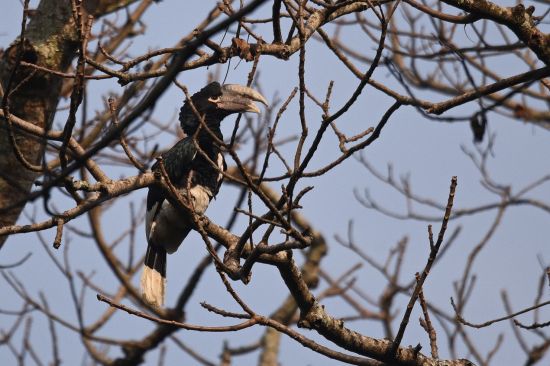- Bycanistes albotibialis
Ceratogymna albotibialis
Identification
60-70cm. A medium-sized to large black hornbill with a white rump.
- White tail with broad black band across centre
- White rump, tail-coverts and belly, broad white trailing edge to wings
- White thighs
- Black rest of plumage
- Brown-tipped feathers on face
- Dark brown bill with creamy base and high tubular casque
- Pale yellow skin around eye
Females are much smaller and have a blackish, smaller bill and casque.
Juveniles similar to adults but with smaller bill and without casque.
Distribution
Found from western to central Africa.
Angola, Benin, Cameroon, Central African Republic, Republic of the Congo, Democratic Republic of the Congo, Equatorial Guinea, Gabon, Nigeria, South Sudan, and Uganda.
A new country record for Tanzania in June 2010 during a birding trip in Minziro Forest in NW Tanzania by Emmanual Gongo and Marcell Claassen and another client. Rarities report submitted to East Africa Rarities Committee.
Taxonomy
This is a monotypic species.
Sometimes considered conspecific with Brown-cheeked Hornbill.
Sometimes included in the genus Ceratogymna.
Habitat
Lowland evergreen forest. Also in adjacent secondary forest and in plantations.
Occurs rarely up to 4000m.
Behaviour
Feeds mainly on fruit, takes also some insects, bird eggs and nestlings.
Usually seen in pairs or in small groups, sometimes in larger groups.
Little known about breeding. Nests in a natural cavity 20-25m up in trees.
References
- Clements, J. F., T. S. Schulenberg, M. J. Iliff, S. M. Billerman, T. A. Fredericks, B. L. Sullivan, and C. L. Wood. 2019. The eBird/Clements Checklist of Birds of the World: v2019. Downloaded from http://www.birds.cornell.edu/clementschecklist/download/
- Del Hoyo, J, A Elliot, and J Sargatal, eds. 2001. Handbook of the Birds of the World. Volume 6: Mousebirds to Hornbills. Barcelona: Lynx Edicions. ISBN 978-8487334306
Recommended Citation
- BirdForum Opus contributors. (2024) White-thighed Hornbill. In: BirdForum, the forum for wild birds and birding. Retrieved 26 July 2024 from https://www.birdforum.net/opus/White-thighed_Hornbill





